#street fighter manhua
Text
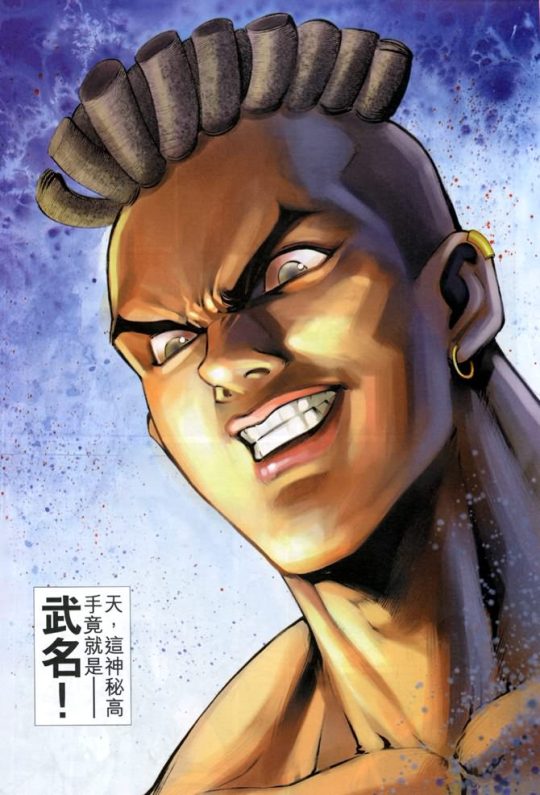
Street Fighter 3: Third Strike Manhua
#manga#manhua#capcom manhua#street fighter manhua#sean street fighter#street fighter#street fighter 3#street fighter 3 third strike#street fighter 3: third strike#sean#sean matsuda#capcom#video games
27 notes
·
View notes
Text
In Asuka's Tekken 5 ending, a heartbeat can be heard when Asuka (accidentally) neutralizes the devil gene in Jin. (Implying Devil Jin didn't have a heartbeat?)
In Tekken 4, when Jin's trying to fight back against the devil gene, he gags and retches - almost as though he's about to throw up. In the Street Fighter x Tekken trailer, Jin is quick to cover his mouth as he feels the devil gene take over. Nausea (and lightheadedness) are symptoms of cardiac issues. (heart attack and cardiac arrest)

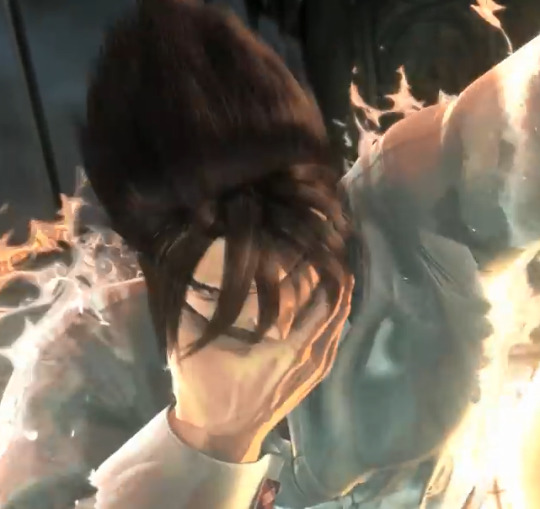
Then there's the Namco x Capcom game, Jin also holds his chest whenever he feels the devil gene coming on.

And lastly, in the Tekken 3 Manhua, it also seems to show Jin's heart giving out after the devil gene takes over, only in a much gorier and explicit depiction than the games show.


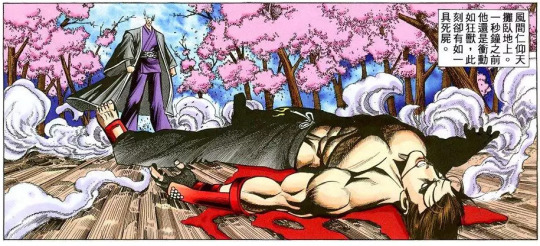
The fact that there seems to be a trend regarding Jin's heart and the devil gene, this leads me to believe that Jin's heart gives out every time DJ takes over. May also be why DJ often has a corpse - like appearance.
#🔥 - ɪᴛ's ᴀ ʙᴇᴀᴜᴛɪғᴜʟ ᴛʀᴀɢᴇᴅʏ // (study)#👿 - ᴀ ʜᴏʟʏ ᴡᴀʀ ᴡɪᴛʜɪɴ // (study)#// I KNOW I'VE TALKED ABOUT THIS BEFORE... but i wanted to compile all the points into one post#// and yah - i know half of this is from non-main games#// BUT. i do find it curious that this is a reoccurring thing#// so i like to hc that - it's just so so so fucked up#// and makes devil jin taking over even MORE painful#blood#gore
7 notes
·
View notes
Text
talking about jan
2023 began a month ago but and i subsequently fell back into my reading, fanfiction and webtoon phase. it’s been like that since 2020, slurping up as much content as i can. i’ve started a new job, a stone’s throw away from home and university is (hopefully) going fairly well.
webtoon reading was one of the many hobbies that stuck when i first discovered its ability to mitigate my anxiety back in early 2021. the hobby gradually made its way into my nightly ‘quiet’ time routine for 5-6 months before i started a different hobby.
but!! for the past few weeks, i mustered the courage to clear my gallery and download ‘webtoon’. i caught up with so many manhwas, mostly new but some were manhwas from back in 2021 that i used to enjoy!!! my favourites would be:
manhwas/manhua/manga:
salad days (kuaikan) - a ballerino and a boxer met at the children’s palace (if you like that childhood friends to lovers trope)
jinx (lezhin) - most importantly, if a manhwa is from lezhin, it’s much likely a BL (and toxic) main character is a professional mma boxer
pearl boy (lezhin) - i really liked this but i only stopped because the main character, dooshik, looked like someone i previously dated 💀 edit: HE LOOKED DIFFERENT AFTER THE AUTHOR WENT ON HIATUS HENCE THE CONTINUATION (spoilers: main character is a gangster so there’s a lot of fighting and violence)
omniscient reader (webtoon) - apparently a very popular manhwa
the boxer (webtoon) - this is such a shonen themed manhwa but i like it!!!
hectopascal (webtoon) - street fighter main character and rich tycoon main character on a revenge partnership
homesick (webtoon) - my latest obsession after Eleceed and Jungle Juice! saving the chapters so i don’t have to wait months for an update
she’s hopeless (webtoon) - high school romcom
the guide to capturing a black lotus (kuaikan) - i like this because it’s such a typical isekai manhua but the art style is so dreamy (like most chinese manhua actually)
games, books, shows, updates:
playstation games: elden ring
recent purchase: hogwarts legacy (pre-order)
switch games: ace attorney trilogy; stardew valley
recent purchase: persona 5 royal
books: jellicoe road; carrie soto is back
currently reading: hp goblet of fire; lockwood & co the screaming staircase
shows: ginny & georgia; the office s1 & 2
anime: chainsaw man; record of ragnarok
btw i no longer have a physical planner so i will be updating this space instead to save the trees 🌳
xoxo gossip girl
ps: i created a pinterest board filled w joo jaekyung’s pictures from jinx it’s called ‘red flag society’ where seungho from painter of the night and jiwon from BJ alex can mingle and talk about how to treat their partners like a puddle of pig’s piss (pearl boy’s dooshik is actually kinda nice and possessed a tinge of kindness so he isn’t required to attend this gathering)
2 notes
·
View notes
Text
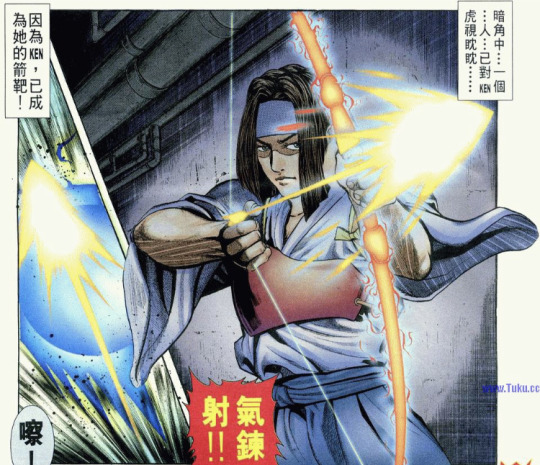

Hokuto from Street Fighter Ex 2 Manhua
4 notes
·
View notes
Note
Necro and Twelve
sadly i don't know much about either but everyone needs to know there's a chinese manhua unlicensed "spinoff" of street fighter where necro is implied to be...a trans woman? nonbinary? it's hard to tell. the word used translates to something not very nice. but NECRO TRANS REAL SHOULD BE A THING...
also i love how twelve wants urien to acknowledge him as his son...it's really sad actually because urien refuses to acknowledge twelve as his son like gill refuses to acknowledge urien as his brother and it's really sad.
6 notes
·
View notes
Photo
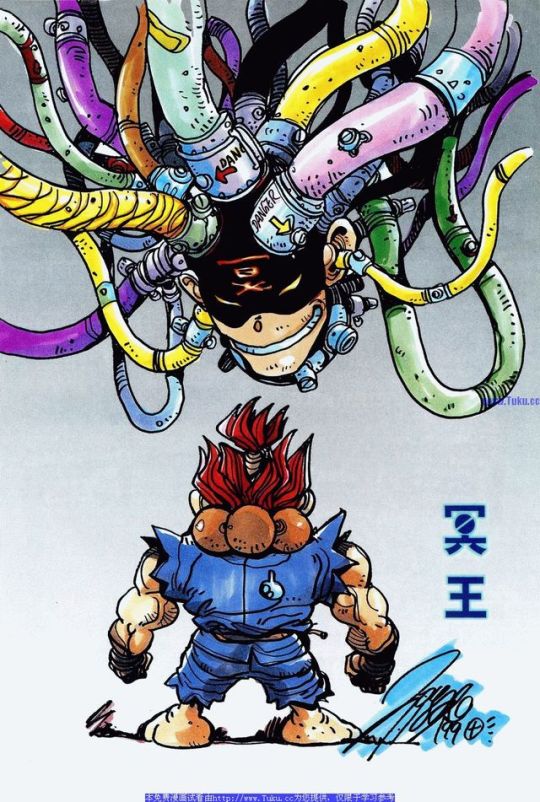
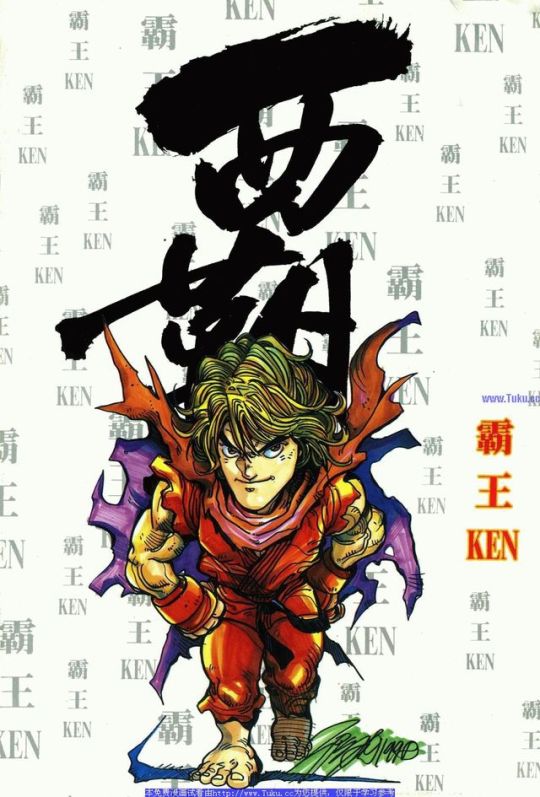




Images at the end of the 1999 Street Fighter EX2 Plus Manhuas depicting some of the forms (mostly “evil incarnations”) of some of the characters from the series.
7 notes
·
View notes
Note
who are some artists u take inspiration from / are some of ur inspirations? love ur art btw :)
Wow I’m so sorry it took me awhile to get back to you anon! This was a hard one. I haven’t thought of my inspirations lately since they have changed a bit. I tried to keep these relevant more to my anime art since that’s what I’m more known for, but some are influences on more of my original art that I hope someday I’ll feel brave enough to share with you all.
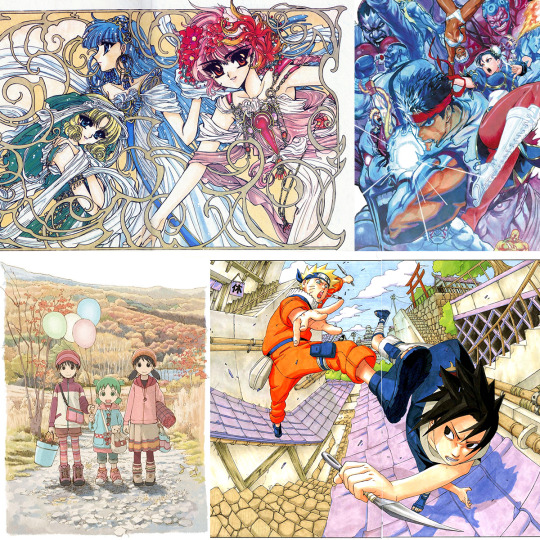
From left to right, top to bottom.
CLAMP (Magic Knight Rayearth) - they were the reason I started drawing manga/anime artwork at all back in early 2000′s for me. The only “shoujo” artists on this list, I was really taken by the eyes they drew at the time and it still can be seen a little bit today, though I’ve really tried to steer myself away from the large pointed eyes with thick lashes and elongated bodies that plagued my art for a long time. I’ll always love their compositions, use of color and just how they use marker.
Yusuke Murata (Street Fighter fan art) - known for Eyeshield21 and One Punch-Man. This man can draw anything. His sense of anatomy, foreshortening and movement is breathtaking. I love the lighting and rendering as well. He also has a knack for creating really original faces and he doesn’t have the “same-face” syndrome problem. Just top-notch. I don’t aim to be as shonen in style as him, but I hope to start being able to add more dynamic poses into my work.
Kyohiko Azuma (Yotsubato!) - known for Azumanga Daioh and Yotsubato! I really love the comedy and slice of life genres lately. I love softer styles and I really adore the more simplistic approach he has to his character design that really allows the slice of life genre to shine through his art. Despite the simplicity, it still is very anatomically technical. It’s simple, but warm and effective and very soft. His skill in backgrounds as well is phenomenal. I think it’s a whole atmosphere he creates and the story he tells in his illustrations that I would love to apply to my own work if I can. I also related a lot to an interview where he stated he struggles blending little Yotsuba into the world he created because she’s so different stylistically from all the characters, so it’s a lot of fun and helpful to see how he accomplishes this throughout the manga and the panels.
Masashi Kishimoto (Naruto) - of course one of my biggest influences due to all the SasuSaku I draw. I think his style is very effective. It’s also I think more on the simpler side actually (if you compare it to CLAMP and Murata’s). But it’s so dynamic and full of strong composition and memorable character designs. I really appreciate how by his influence, I never really stopped drawing thanks to the characters, Sasuke and Sakura, that he created that had such an impact on me.
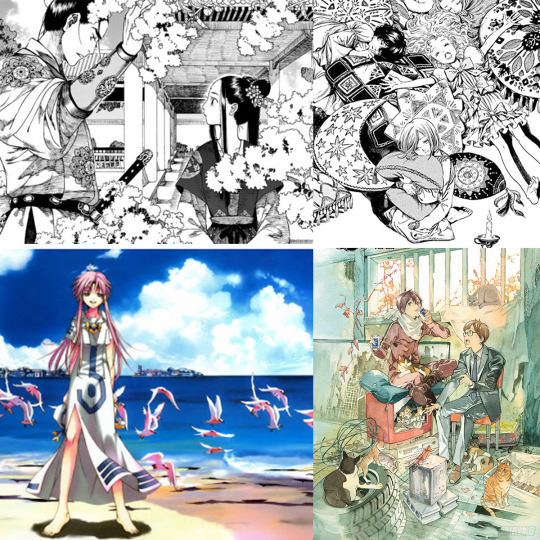
Xia Da (Song of the Long March AKA Choukakou) - This one is a manhua artist. Her inking and watercolor artwork is absolutely phenomenal. Definitely someone I look up to when I’m inking my own pieces, I would love to be at her level of skill someday. Primarily an inspo for inking.
Kamome Shirahama (Atelier of Witch Hat) - another artist with phenomenal inking skills that I really admire. She’s also really good at drawing children! But I definitely believe she can draw anything, the fact that she has crossed the barrier to illustrate comic covers for both DC and Marvel is just incredible to me and a testament to how much skill she possesses. Primarily an inspo for inking.
Kozue Amano (Aria) - Known for Aqua, Aria, and Amanchu (lots of A’s!). Her ability to design precious soft characters, gorgeous scenery, and write a beautiful and gentle slice of life fantasy tale has always made her one of my absolute favorites. I absolutely love how she colors her works.
Adachitoka (Noragami) - this is a team who does characters and background art. It’s not a secret that I love watercolor. I also love the movement and action and fighting scenes from this manga. The fact that this team is female and broke through with a popular shonen series is simply amazing. I hope to be as good as they are in drawing figures and in watercolor someday.

James Gurney (Dinotopia) - the master of creating fantasy worlds and making it look like it EXISTS with his painting skills. His “Color and Light” book is an absolute staple (I have it always ready as reference) and it’s a must if you want to give your lighting that more realistic feel. I think my love of lighting really came from growing up with the Dinotopia series. He is always constantly sharing his wisdom as well on his website and twitter and just an amazing and inspiring person for generations of artists.
Makoto Shinkai (Kimi no Na Wa) - This movie’s aesthetics (especially the lush backgrounds), surrealism, and existentialism really spoke to me. I adore the starry skies and heavens and clouds. Screencaps of his movies fill my phone as a quick reference whenever I’m rendering some complex lighting or trying to create some sort of composition with the sky.
Studio Ghibli/Hayao Miyazaki (Kiki’s Delivery Service) - nothing really needs to be said especially given my love for the details in all the movies, the fantastic scenes involving flying in the sky, the gorgeous backgrounds, and the delicious food. Always a good choice to use as a reference for anything with nature or even cluttered cozy houses and rooms and greenhouses. It’s still a desire to delve more into world building for me and I’ll be using these movies for reference. I also keep tons of their artwork in my phone as reference.
Satoru Takizawa (Legend of Zelda, Breath of the Wild) - Known for his work with Twilight Princess and Breath of the wild. You know where I’m going with this - he is the MASTER of ambient lighting. I love his rough and loose painting style that I wish I could achieve someday, but I still have a tendency to over-render. A great resource for learning how to world-build and for concept art.

Andrew Loomis - anatomy and figure drawing master. At the end of this list, but not the least important by a long shot. His book I think is not the most beginner friendly in terms of seeing basic shapes and breaking down the form (I think his construction is still more on the complex side), but it’s a good place to start and keep grinding until it “makes sense.” It took me years, but once it started clicking, I have him to thank for it because my anatomy was an absolute mess because of my background of starting from CLAMP’s art style. Buy his book and make it your bible. Attend figure drawing classes. If you want to illustrate people no matter how simple, you must make studying anatomy a part of your process.
Lastly - some original artists to check out who I like the inking, watercolor skills, and concepts of that closely align with my interests for my own original art.
meyoco - twitter, instagram
maruti_bitamin - twitter, instagram, tumblr
Qinniart - twitter, instagram
Some mangaka honorable mentions -
Takeshi Obata (Death Note, Bakuman)
Kaoru Mori (Emma, Otoyomegatari)
Satsuki Yoshino (Barakamon)
This was super long, I apologize, but it’s something I’m passionate about. I love art to pieces. I think a lot of what I admire is very technical - anatomy and lighting. I think my influences also reflect my aim to be more proficient at watercolor and inking. And lastly, world-building, fantasy/cosmos, and background art. I think a lot of what I really love though, is color and lighting and that’s found within any of these artists. :)
Thanks for the question anon! You allowed me to geek out on art for about an hour while I wrote this out.
17 notes
·
View notes
Text
10 Best Sonny Chiba Movies You Need to Watch Right Now
https://ift.tt/eA8V8J
On August 19, 2021, legendary Japanese actor Sonny Chiba succumbed to complications from Covid-19. He was 82. If you don’t know Chiba, he was a pioneering martial arts movie stars and a genuine master of the martial arts. Long before Bruce Lee, there was Sonny Chiba.
Chiba was his stage name. He was born as Sadaho Maeda and adopted “Chiba” after Japan’s Chiba prefecture where he grew up. His Japanese stage name was Shinichi Chiba, but he was known internationally as Sonny.
Chiba was a natural athlete and a contender for Japan’s Olympic gymnastics team until he was sidelined by an injury. He pivoted to study Karate under the venerated master Mas Oyama, a hardened full-contact fighter who was famous for killing bulls with his bare hands. Chiba went on to earn black belts in several schools of Karate, as well as Judo, Kendo, and Ninjitsu.
In the 60s, Chiba began his acting career in television, specifically in the costumed superhero genre known as tokusatsu (think Ultraman or Mighty Morphin Power Rangers). From there, he jumped to crime thriller movies and quickly established himself as an action star. In 1970, he formed the Japan Action Club, one of the first groups dedicated to stunt people and martial arts actors. His first explicitly martial arts film part was in 1973 in a film called Karate Kiba.
Chiba is credited with over 200 roles, predominantly in Japanese martial arts films, however he’s appeared in a few Hollywood projects. While he’s known in the west for his martial arts performances, he’s delivered a wide range of characters, mostly leaning towards grindhouse cinema. Since 1959, Chiba has delivered several projects almost every year. The bulk of his work over the last two decades were direct-to-video projects. His final film Bond of Justice: Kizuna, a Yakuza revenge tale, is in post-production and is slated to be released later this year.
In honor of Sonny Chiba’s illustrious career, Den of Geek has cherry-picked several of his best and most interesting films.
Invasion of the Neptune Men (1961)
Since Chiba got his start in tokusatsu, we had to include at least one title from this uniquely Japanese genre, and this one is truly vintage, shot in black and white. Chiba plays an astronomer with a secret superhero identity. He transforms into Space Chief, a caped crusader clad in a metal helmet and sunglasses who is a friend to little children. Meanwhile, the titular Neptune Men are dressed in classic 1950s-style alien costumes, all silvery with ridiculous bucket-like helmets. Yes, this is one of those films that’s so incredibly bad that it’s good, so much so that it caught the attention of Mystery Science Theater 3000, which is the best way to watch it.
The Street Fighter (1974)
The Street Fighter was a game changer, one of the very first modern Japanese martial arts films to get international distribution. Riding on the wake of one of the first globally distributed Chinese martial arts films, Five Fingers of Death (1972), The Street Fighter established Chiba as a martial arts star in the eyes of the world. If you’re only going to watch one Sonny Chiba movie ever, this is the one. It was the defining role of his career.
Chiba plays the antihero Teri Tsurugi, whose nickname is “Real mean bastard.” It’s a gratuitously violent film for the time, unapologetically so with Tsurugi ripping out throats, breaking necks with wild abandon, and selling women as sex slaves, often while shirtless to show off his macho barrel chest. When The Street Fighter was released in the U.S., it was the first film to get an X rating for violence.
Chiba reprised the role twice in 1974 with Return of the Street Fighter and The Street Fighter’s Last Revenge. The franchise also spawned a spin off trilogy, Sister Street Fighter, starring another genuine martial artist and actress, Etsuko Shihomi. Shihomi frequently starred alongside Chiba. She appeared in Karate Kiba and its sequel, as well as in the original Street Fighter films. Chiba appears in Sister Street Fighter, but as a completely different character than Tsurugi.
Wolf Guy: Enraged Lycanthrope (1975)
This is not a Mystery Science Theater film, but it should be. Wolf Guy is a hard-to-find cult film where Chiba plays Akira Inugami, the last survivor of a clan of werewolves who uses his lupine powers to solve crimes. However, when the moon triggers him (or a comet or the birth of a two-headed calf – Inugami is easily triggered), Inugami doesn’t transform into a hairy beast. He just gets super wolf powers. It’s a strange film, not for everyone except for those who love psychotropic Japanese cinema.
Note that the Japanese title of this film is Urufugai and that’s a phonetic translation of “wolf guy.” “Urufu” is “wolf’ and “gai” is “guy.” This is an example of wasei-eigo, literally “Japanese-made English.” “Anime” is another wasei-eigo term, derived from the English word “animation.” The Japanese title of Karate Kiba is Bodigaado Kiba – Bodigaado is “Bodyguard.”
Karate Bullfighter aka Champion of Death (1975)
Chiba played his illustrious sensei Masutatsu “Mas” Oyama in a film trilogy based on a biographical manga titled Karate Baka Ichidai (Karate fanatic) by Ikki Kajiwara that began in 1971 and ran until 1977. Karate Bullfighter was the first. Karate Bearfighter came out the same year and Karate for Life was two years later. There’s also an anime version of the manga that came out in 1973. The manga and anime are credited with stimulating a Karate trend in Japan.
Oyama Sensei had cameos in the first two films. Oyama was Korean, born in Korea while it was under Japanese rule. His birth name was Choi Yeong-eui, but he changed his name after immigrating to Japan in 1938. He died of lung cancer in 1994.
Golgo 13: Assignment Kowloon (1977)
Based on the popular manga series, launched in 1968 and still running to today, Golgo 13 is Japan’s answer to James Bond. He’s an international assassin, a crack shot sniper with Karate chops. Chiba plays Golgo 13 on a mission to sanction a Hong Kong crime boss. This is a classic ’70s grindhouse film, and Chiba captures Golgo 13’s cold-blooded ruthlessness with his signature vicious aplomb.
Message from Space (1978)
In the wake of Star Wars, Message from Space was a blatant rip-off with a tokusatsu bent. It had Japan’s biggest budget at the time, but you wouldn’t know it now. It’s horribly dated with cheesy special effects, another “so bad it’s good” movie — Mystery Science Theater could have a field day with Chiba’s filmography. Chiba and his street fighting counterpart Etsuko Shihomi shared top billing alongside Vic Morrow.
Hunter in the Dark (1979)
We had to include one of Chiba’s period films, and Hunter in the Dark is a fine example of the samurai genre. Led by one of the greatest samurai film actors of all, Tatsuya Nakadai, and directed by the influential Hideo Gosha, Chiba is in a supporting role as Shimoguni Samon. When the grindhouse films get too much, this is a welcomed change — an unsung masterpiece by some of the leaders of the samurai genre.
The Storm Riders (1998)
The Storm Riders was another gamechanger, an epic Chinese fantasy martial arts film based on the manhua by Ma Wing-shing (manhua is Chinese comics like manga is Japanese comics). Starring Ekin Cheng and Aaron Kwok, this special effects-driven film won many accolades at Asian film festivals and ushered in a new era for the period martial arts fantasy film genre known as wuxia. Chiba played the villain, Lord Conqueror.
Kill Bill: Volume 1 & 2 (2003 & 2004)
Quentin Tarantino cast Chiba as Hattori Hanzo, the retired swordmaker and sushi chef who created the Bride’s (Uma Thurman) katana. It was an homage role. Tarantino was paying respects to Chiba as a longtime fan. He also inserted easter eggs honoring Chiba’s work in Pulp Fiction. When Jules Winnfield (Samuel L. Jackson) claims to quote Ezekiel 25:17 – “The path of the righteous man…” – it’s a reference to the opening of Karate Kiba, which paraphrases the same passage in the American version.
The Fast and the Furious: Tokyo Drift (2006)
Chiba played Kamata, a yakuza boss and the father of the films main rival. Like with Kill Bill, Chiba’s Hollywood roles are the most cited in his obituaries, but both were minor in comparison to his vast and diverse body of work.
A prolific actor who did most of his own stunts long before Jackie Chan claimed to do so, Chiba was a cinematic maverick who attacked moviemaking with an unprecedented and unapologetic sense of ultraviolence. While many of his films seem dated and low brow now, his impact on action film is undeniable and his passing marks an incalculable loss to the genre.
cnx.cmd.push(function() { cnx({ playerId: "106e33c0-3911-473c-b599-b1426db57530", }).render("0270c398a82f44f49c23c16122516796"); });
The post 10 Best Sonny Chiba Movies You Need to Watch Right Now appeared first on Den of Geek.
from Den of Geek https://ift.tt/3ke3huG
1 note
·
View note
Text
On Hong Kong Comics (in Indonesian)
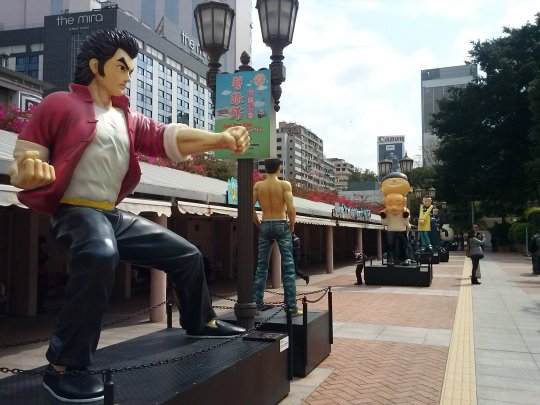
SEPTEMBER 2018
Komik Hong Kong di Indonesia: Kian Elit, Kian Sempit
Oleh Ade Irwansyah
Jika bertandang ke Hong Kong, sempatkanlah mampir ke Kowloon Park, sebuah taman dekat kawasan Tsim Sha Tsui yang sibuk. Di salah satu sudut taman terdapat surga kecil buat pecinta komik, terutama komik Hong Kong. Di area sepanjang 100 meter terdapat 30 patung karakter tokoh komik Hong Kong setinggi 1,8 hingga 3 meter berderet rapi.
Patung-patung yang dipamerkan di situ merentang dari karakter komik era 1960-an hingga dekade 2010-an. Di sana, Anda bisa puas berswa-foto dengan karakter Old Master Q, Wang Xiao Hu dari komik Long Hu Men, Dragon Lord, Cloud alias Angin dari komik Awan dan Angin (Wind and Cloud/Storm Riders) sampai yang kurang dikenal di sini seperti Miss 13 Dots, K si James Bond Hong Kong atau Ding Ding Penguin yang imut.
Tempat yang dinamakan Hong Kong Avenue of Comic Stars ini juga memuat sejarah perkembangan komik, pengaruhnya ke negara lain, termasuk Indonesia. Hong Kong Avenue of Comic Stars resmi dibuka September 2012 dengan tujuan merayakan budaya komik negeri bekas koloni Inggris itu.[1] Pembukaannya diresmikan Tony Wong Yuk-long, Presiden Hong Kong Comics and Animation Federation dan Gregory So Kam-leung, Menteri Perdagangan dan Pembangunan Ekonomi Hong Kong.
Tony Wong, tentu saja, legenda hidup komik Hong Kong. Ia layak disejajarkan dengan Osamu Tezuka di Jepang atau Stan Lee di Amerika. Seperti Stan Lee pula, Tony Wong beberapa kali muncul di film layar lebar. Ia pernah main film Project A (sebagai polisi), All’s Well, End’s Well (sebagai diri sendiri), New Police Story bareng Jacky Chan (sebagai kepala penjara) dan film adaptasi komik karyanya Dragon Tiger Gate (sebagai tabib Qi).[2] Membicarakan komik Hong Kong tak sahih tanpa menyebut Tony Wong. Namun, sejatinya pula, nama itu baru muncul sekitar akhir 1960-an di rimba persilatan komik di sana.
Bila ditelusuri muasal komik Hong Kong akan jauh sekali hingga ke masa Tiongkok kuno. Seperti Indonesia, orang China telah mengenal budaya gambar sejak ribuan tahun silam. Jejak lukisan tertua yang terselamatkan menunjuk ke masa abad 11 SM dan gambar-gambar di guci dari masa 5.000 sampai 3.000 SM. Di masa Dinasti Ming (1368-1644) muncul gambar dengan teknis kuas, sedangkan di masa awal Dinasti Qing (1643-1911) lahir gambar satir karya Zhu Da serta Luo Liang-feng sekitar 1771.[3]
Perkembangan gambar modern di China tak bisa dipisahkan dengan teknik cetak murah dari Barat. Teknik cetak ini membuat penerbitan koran dan majalah menjamur. Termasuk juga kartun dan karikatur yang muncul dalam koran dan majalah tersebut. Selain di media cetak, lahir juga apa yang dinamakan lianhuantu, buku cerita bergambar seukuran telapak tangan. Lianhuantu berformat 30 halaman. Setiap halaman berisi gambar dengan kotak keterangan di bawahnya. Komik format lianhuantu banyak diterbitkan di Shanghai awal abad ke-2o, serta diekspor keluar, di antaranya Hong Kong. Lianhuantu biasanya mengisahkan cerita kepahlawanan pahlawan atau legenda Tiongkok kuno.[4]
Di buku Hong Kong Comics (2002), Wendy Siuyi Wong menyebut komik Hong Kong pertama lahir di akhir abad ke-19 dan awal abad 20. Komik Hong Kong awal berjenis kartun satir dan karikatur. Majalah kartun satir pertama The China Punch terbit 1867 oleh seorang wartawan Inggris. Namanya sendiri diambil dari The Punch, terbitan Inggris dan mengadopsi karikatur politik, lustrasi dan kartun satir.
Siuyi Wong menganggap peran The China Punch sangat berarti karena mengenalkan kartun dan humor politik di Hong Kong.[5] Orang China pertama yang melukis kartun politik di Hong Kong adalah Tse Tsan-tai lewat karyanya The Situation in the Far East yang diterbitkan di Jepang. Tse pendukung Sun Yat-sen, Bapak Republik China. Ia menentang ambisi negeri asing di China. Lewat karyanya, ia bermaksud memberi kesadaran politik pada rakyat China.[6]
Dari Komik Humor ke Kungfu
Dalam bahasa China, komik disebut “manhua”. Sejumlah sejarawan meyakini kata itu dipinjam sejak permulaan abad ke-20 dari bahasa Jepang, manga yang berarti komik.[7] Menginjak 1920-an dan 1930-an, komik Hong Kong jarang memuat pesan politik. Topik yang sering diangkat kebanyakan tema sehari-hari. Selepas Perang Dunia II, komik jadi hiburan orang banyak. Komik strip muncul di setiap koran menggambarkan keseharian orang Hong Kong, dengan dialog sehari-hari dalam bahasa Kanton alih-alih Mandarin.[8]
Tahun 1950-an terbit Uncle Choi karya Hui Guan-man. Awalnya, kisah Paman Choi ini bernuansa humor, tapi belakangan jadi serius saat fokus cerita beralih soal kepahlawanan perang lawan Jepang. Di masanya, Uncle Choi jadi manhua terlaris di Hong Kong selama beberapa tahun, terbit selama satu setengah dekade. Komiknya dikatakan membawa pembaruan dengan gaya bertutur modern yang membedakan dengan model lianhuantu. Wendy Siuyi Wong mencatat manhua ini mengikuti tren—misal, ketika film spionase James Bond populer, sang tokoh jadi mata-mata--walau tak selalu disambut baik pembaca. Pada pertengahan 1970-an penerbitannya dihentikan.[9]
Sebelum 1970-an, manhua populer lainnya adalah Old Master Q karya Wong Chak yang terbit pertama tahun 1964. Formatnya komik empat panel yang mengisahkan petualangan kocak Old Master Q, pria tua berkumis tipis dan kostum tradisional China, bersama kawan-kawannya (“Big Dumb”atau “Big Potato” dan Mr. Chun). Manhua ini masih terbit hingga hari ini membuatnya jadi serial komik China paling lama.[10]
Yang kini juga jadi klasik di masa itu adalah Miss Thirteen Dot yang muncul di komik 13-Dot Cartoons karya Theresa Lee Wai-chun. Manhua ini disebut komik mainstream pertama yang menyasar pembaca cewek. Dikatakan, komik ini terinspirasi karakter Richie Rich. Ceritanya sendiri tentang petualangan seorang gadis putri jutawan.[11]
Seiring popularitas film kungfu akhir 1960-an dan tahun 1970-an yang antara lain melahirkan sosok Bruce Lee, imbasnya juga sampai ke manhua. Tahun 1971 terbit manhua kungfu berjudul Lee Siu-lung yang merupakan nama China Bruce Lee karya Seung-gun Siu-bo. Akhir 1960-an, tepatnya 1968, terbit Little Vagabond karya Tony Wong berkisah tentang petualangan dewa mabuk Vagabond.
Namun, tak sah mengulas manhua kungfu tanpa menyebut karya Tony Wong yang lain, Little Rascals (1970). Manhua ini mengisahkan petualangan preman-preman muda yang tinggal di pemukiman rumah susun (public housing) Hong Kong. Penggambaran adegan duel di komik ini begitu brutal dan mengundang kritik. Pemerintah lantas menerbitkan Indecent Publication Law tahun 1975 untuk mengatur gambar kekerasan vulgar di komik. Tony Wong patuh. Mengubah judulnya bernada positif Oriental Heroes (Long Hu-men). Tahun 1980-an, gaya gambar ala kartun di manhua ini berubah jadi lebih realis seiring popularitas The Chinese Hero karya Ma Wong-shing.[12] Pada akhir 2000, Wong me-remake Oriental Heroes dengan judul Xin Long Hu-men (New Oriental Heroes), memakai karakter yang sama seperti Wang Xiaohu, Wang Xiaolong dan Shi Heilong, tetapi dengan cerita yang lebih memikat dan adegan laga yang jauh lebih mantap.[13]
Pengaruh Komik Hong Kong di Indonesia
Di buku Komik Indonesia (pertama terbit edisi Prancis, 1976; edisi Indonesia, 1998) Marcel Bonneff mencatat komik silat kita bermula dari cerita silat (cersil) China. Ia tak menyebut komik melainkan karya sastra. Sebelum Perang Dunia II, surat kabar Melayu-Tionghoa Keng Po dan Sin Po menerbitkan seri silat China, yang kemudian terbit dalam bentuk buku. Setelah perang, Koran Star Weekly sangat diminati karena memuat cersil China.[14]
Dikatakan juga, cersil China di Indonesia dapat digolongkan ke dalam dua kelompok: cersil Tionghoa terjemahan buku yang diterbitkan di Hong Kong dan Taiwan serta gubahan penulis Indonesia keturunan Tionghoa. Yang disebut terakhir pelaku utamanya adalah Kho Ping Hoo alias Asmaraman.[15]
Dalam format komik, salah satu cersil pertama adalah kisah legenda Sie Djin Koei pada 1954. Komiknya tak mengadopsi model lianhuantu ala cergam Shanghai awal 1920-an, namun sudah sepenuhnya mengadopsi format komik modern dengan panel-panel terpisah dan balon kata.[16] Menginjak 1960-an terbit komik Buku Angin Kuning atau Pendekar Piatu yang mengambil ilham dari cersil China. Di pasar Indonesia, kata Bonneff, komik Hong Kong mendapat tempat sejajar dengan buku cerita.[17]
Yang turut pula berpengaruh pada komik silat kita adalah film kungfu Hong Kong, Taiwan dan samurai Jepang yang tayang di Indonesia di masa awal Orde Baru, akhir 1960-an dan awal 1970-an. Ganes TH yang mencipta Si Buta dari Gua Hantu dikatakan meniru komik Hong Kong, atau setidaknya film Jepang. Ganes membantah, mengatakan yang menginspirasinya adalah film Amerika tentang koboi buta yang beraksi dengan tongkat.[18]
Masa keemasan komik Hong Kong alias manhua di Indonesia berlangsung tahun 1990-an. Saat itu industri komik lokal tengah terpuruk oleh serbuan komik impor. Bila dekade sebelumnya orang Indonesia akrab dengan komik Eropa (Tintin, Asterix, Lucky Luke) dan Amerika (Batman, Superman dll), pada 1990-an mulai menjamur komik Jepang dan Hong Kong. Komik Jepang alias manga ditanadi oleh Candy Candy, Kung Fu Boy dan Doraemon yang diterbitkan Elex Media Komputindo milik Kompas-Gramedia; sedangkan manhua ditandai kehadiran dua karya Tony Wong: Tiger Wong dan Tapak Sakti juga oleh Gramedia. Tiger Wong judul aslinya Oriental Heroes versi 1980-an, sedangkan Tapak Sakti adalah Buddha’s Palm terbitan 1982.
Tahun 1990-an pemainnya bukan hanya kelompok usaha Kompas-Gramedia. Generasi ’90-an penggemar komik pasti akrab dengan manhua terbitan Garuda Mas. Penerbit ini menerbitkan banyak komik terjemahan Hong Kong macam Street Fighter, Crazy Guy, 3 Pendekar, Killer Sword dan macam-macam lagi. Di kebanyakan terbitan itu hanya disebut nama penulisnya, Chris Lau (Lau Ding-gin), padahal komik-komik itu dihasilkan macam-macam komikus: Fung Chi-ming, Li Chi-tat, dan lain-lain.
Jelang pertengahan 1990-an, Garuda Mas menghilang digantikan Rajawali Grafiti. Penerbit ini menerbitkan komik Hong Kong bajakan seperti Dragonman (Dragon Lord) hingga Awan dan Angin (Wind and Cloud) dan Pedang Bara (The Chinese Hero) dua karya legendaris Ma Wing-shing. Selain itu penerbit yang sama juga banyak menerbitkan manga terjemahan tak resmi seperti City Hunter, Dragon Ball, Ranma ½ hingga Tinju Bintang Utara (Fist of the North Star karya Burunson). Tidak sampai akhir 1990-an penerbit ini tak terdengar lagi kiprahnya.
Nasib Manhua Kini di Hong Kong dan Indonesia
Masa keemasan komik Hong Kong baik di negeri asalnya maupun Indonesia berlangsung hingga 1990-an. Di Indonesia malah rasanya masa emas itu lebih pendek: hanya setahun, tepatnya 1992 ketika Gramedia menerbitkan Tiger Wong dkk serta Garuda Mas membanjiri pasar dengan judul-judul beragam.
Penyebab kemunduran relatif sama: serbuan manga ke pasar. Di Hong Kong, dari segi format, manga yang terbit bulanan, hitam-putih, dicetak di kertas biasa dengan tebal 200-an halaman dianggap lebih memuaskan. Sedangkan manhua terbit mingguan, dicetak di kertas art-paper warna dengan tebal 30-40 halaman. Pembaca rupanya lebih memilih baca manga.[19]
Penyebab lainnya adalah abad digital yang mengubah kebiasaan orang membaca di kertas ke perangkat digital, baik komputer hingga handphone. Internet jadi biang keladi utama lantaran menyediakan komik hasil pindai (scan) gratis. Seorang pelaku bisnis komik dan animasi Hong Kong dikutip media setempat mengatakan pada 1995 hingga 2000 industri itu menghasilkan 700 juta dollar HK. Pada 2010, tinggal 300 juta dollar HK.[20]
Meski tak segurih era 1990-an bukan berarti industri manhua mati. Dari abad digital ini malah lahir komikus indie yang tak menggantungkan diri pada penjualan buku komik. Karena tak mengandalkan selera pasar pula, ekspresi kesenian mereka lebih personal. Yang lahir dari tangan mereka bukan lagi komik kung fu dengan jurus-jurus spektakuler, namun kisah keseharian dan keresahan hidup.
Yang patut disebut di sini antara lain How Blue was My Valley karya Yeung Hok-tak. Komik ini diterbitkan mandiri pada 2002. Kisahnya semacam memoar pengarangnya tentang kehidupan di rumah susun pemerintah (public housing) pada 1970-an. Gaya gambarnya berlainan sekali dengan manhua umumnya. Di komik ini manusia umumnya digambar seperti bayangan.[21]
Sayang beribu saying perkembangan komik Hong Kong kiwari tak sampai ke Indonesia. Manhua masih dijual di toko buku. Namun kebanyakan komik kung fu gubahan Tony Wong dan Andy Seto. Manhua Long Hu Men dan beberapa judul lain bisa ditemukan di toko buku kita. Kini pun yang tersisa tinggal manhua terbitan Gramedia. Sempat hadir Kumala Komik dengan judul-judul beragam, tapi menghilang juga tanpa kabar.
Manhua yang tersisa untuk dinikmati dalam bahasa Indonesia, selain hanya berjenis komik silat, juga harganya relatif mahal. Satu eksemplar dijual sekitar Rp 100 ribu. Bukunya memang tebal (hampir 200 halaman) dan dicetak di kertas art paper kinclong. Bandingkan dengan komik Jepang yang dijual di kisaran Rp 25 ribu.
Harga mahal itu menandakan yang disasar penerbit mereka yang berkocek tebal. Terutama generasi X dan milenial kelahiran awal 1980-an yang ketika kecil tumbuh membaca komik Tiger Wong dan Tapak Sakti yang dijual Rp 2.000 pada 1990-an. Mereka kini memang telah berada di puncak karier masing-masing, berpenghasilan berlebih. Membaca Long Hu Men kini buat mereka punya nilai nostalgis.
Bahaya dari strategi pasar model begini adalah penerbit tak hendak menyasar pembaca baru: mereka yang tak mampu beli komik seharga Rp 100 ribuan. Ini membuat pasar komik Hong Kong jadi elitis dan sempit. Amatilah toko buku. Manhua menyempil di rak sempit, terdesak puluhan judul manga. Begitulah nasibnya kini.***
[1] "Avenue of Comic Stars opens in Kowloon Park with statues of characters", South China Morning Post, 29 September 2012, dengan URL: https://www.scmp.com/news/hong-kong/article/1049718/avenue-comic-stars-opens-kowloon-park-statues-characters (diakses 29 Agustus 2018).
[2] Lihat Long Hu Men Guidebook, PT Gramedia, Jakarta, 2013, hal. 87.
[3] Lihat Wendy Siuyi Wong, Hong Kong Comics: A History of Manhua, Princeton Architectural Press, New York, 2002, hal. 11.
[4] Ibid, hal.103.
[5] Ibid, hal. 12-13.
[6] Ibid.
[7] Ibid, hal. 11.
[8] Sally Gao, “An Introduction to Hong Kong Comics”, Culture Trip, 29 Oktober 2016, dengan URL: https://theculturetrip.com/asia/hong-kong/articles/an-introduction-to-hong-kong-comics/ (diakses 6 September 2018).
[9] Lihat Wendy Siuyi Wong, Hong Kong Comics…,hal. 107.
[10] Ibid, hal 67 dan lihat Sally Gao,…
[11] Wendy Siuyi Wong, Hong Kong Comics…,hal. 73.
[12] Ibid, hal. 115.
[13] Lihat Long Hu Men Guide Book… hal. 3.
[14] Marcel Bonneff, Komik Indonesia, Cet. 3, Kepustakaan Populer Gramedia, Jakarta, 2008, hal. 115.
[15] Ibid.
[16] Ibid, hal. 118.
[17] Ibid, hal. 120.
[18] Ibid.
[19] Lihat “Japanese Elements in Hong Kong Comics: History, Art, and Industry”, dimuat di URL: http://www.cuhkacs.org/~benng/Bo-Blog/read.php?456 (diakses 6 September 2018)
[20] Lihat Nan-Hie In, "Hong Kong’s comics industry is proverbially in the shreds. The biggest saboteur? The internet", Coconuts Hong Kong, 30 Agustus 2014, dengan URL: https://coconuts.co/hongkong/features/hong-kongs-comics-industry-proverbially-shreds-biggest-saboteur-internet/ (diakses 6 September 2018).
[21] Lihat Jeffrey Mather (2017), “Hong Kong Comics: Reading the Local and Writing the
City”, Wasafiri, 32:3, 79-86, DOI: 10.1080/02690055.2017.1322325, di URL:https://doi.org/10.1080/02690055.2017.1322325 (diakses 6 September 2018).
CATATAN: Esai ini adalah versi belum diedit dari esai yang dimuat Jurnal Ruang dengan URL: https://jurnalruang.com/read/1537275375-komik-hong-kong-kian-elit-kian-sempit.
0 notes
Photo

Street Fighter 3: Third Strike Manhua
#manhua#street fighter manhua#capcom manhua#ryu#ryu street fighter#street fighter#comics#capcom#video games#3rd strike#street fighter 3: third strike#street fighter 3#street fighter 3 third strike#third strike
69 notes
·
View notes
Photo
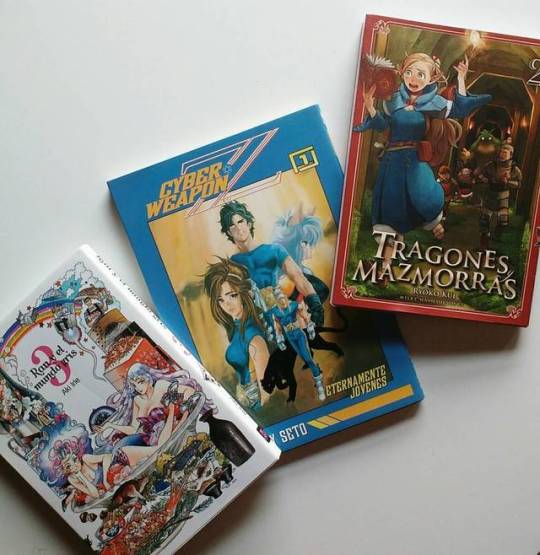
(Pack manga fantasía y... Cyber Weapon Z) - Pues todo absurdamente bien. 1⃣ (Ran y el mundo gris #3) - La serie sigue sigue su tónica de capítulos autoconclusivos de temática cotidiana y mágica mientras se expande el entorno de la familia protagonista. Tenemos un poco más de ecchi en este tomo, pero no me resulta especialmente molesto, porque le veo su razón de ser argumental, y al menos hay una respuesta lógica de los personajes a esas escenas. Pero no nos pasemos tampoco. Me he reído bastante, gracias sobre todo a la traducción (esos "virgen santísima" y "la he liado parda", impagables). Me sigue encantando. 2⃣ (Cyber Weapon Z #1) - Voy a intentar contaros la historia en pocas palabras: esto es mi infancia. Tendría yo... ¿10 años? Y compraba revistas de manga como la Dokan. Y en una de ellas creo que este manhua aparecía en portada. Y venía un poster con la portada de este tomo. Poster que estuvo en mi pared durante años. Me transmitía un aire de Street Fighter con DBZ, pero nunca llegué a comprobarlo. La serie llegó a publicarse en España: de 10 tomos, solo 4. Y ahora, casi 20 años después, he podido leer el primero. Me ha parecido fascinante. Puro años 90. Algunas ilustraciones (con un color muy Masamune Shirow bastante cojonudo) estilo videojuego de lucha muy impactantes, algunas gotas de trama futurista, y una narración que no tiene ni pies ni cabeza. Es para verlo. 3⃣ (Tragones y Mazmorras #2) - La dejé un poco aparcada por acumulación y porque es de estos mangas que te da la impresión de que se va a volver repetitivo (¿hasta donde puede durar la originalidad cuando se habla de gastronomía en las mazmorras?) pero la verdad es que me ha vuelto a resultar ligero y agradable... Con algún punto humoristicamente siniestro. #manga #shojo #seinen #shonen #manhua #cyberweaponz #andyseto #ranyelmundogris #akiirie #ryokokui #tragonesymazmorras #dungeonmeshi #milkywayediciones #tomodomo #comic #bamf #comicfreaks
#milkywayediciones#dungeonmeshi#1#ryokokui#bamf#2#tomodomo#comic#comicfreaks#3#akiirie#tragonesymazmorras#shojo#shonen#cyberweaponz#manhua#manga#ranyelmundogris#seinen#andyseto
0 notes
Photo
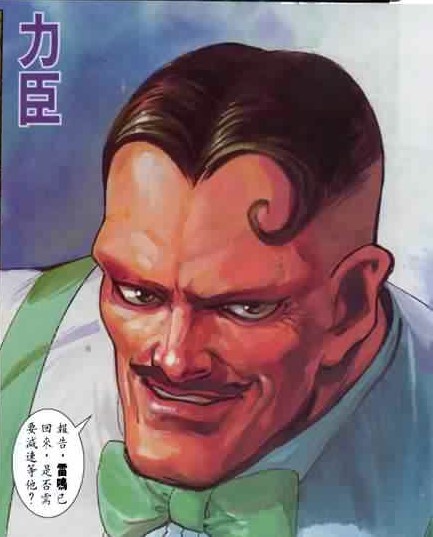
Dudley from Chapter 1 of the street Fighter 3: Third Strike Manhua
#manhua#street fighter manhua#dudley#dudley street fighter#video game comics#video games#capcom#street fighter#third strike#street fighter 3: third strike#street fighter 3 third strike#street fighter 3
10 notes
·
View notes
Text

Street Fighter 3: Third Strike Manhua Ch. 2 Cover Art
#street fighter#capcom manhua#manga#manhua#street fighter comics#video game comics#street fighter 3 manhua#street fighter 3: third strike manhua#street fighter 3#street fighter 3: third strike#third strike#capcom#makoto's face
51 notes
·
View notes
Text
hugo fits quite a few stock shonen hero traits, from what i’ve noticed, especially in the japanese version where he’s more energetic and cheerful! he’s:
-courageous/reckless (so much so that poison has to rein him in)
-energetic
-honorable (he keeps his honor to his mama in most continuities, most notably the ryu final manga)
-stubborn to a fault (DEFINITELY this)
-pursues a big end goal (being the greatest wrestler in the world)
-simpleminded (very much so, being very simpleminded and childlike in most street fighter versions)
-hardworking on their field of expertise (that being wrestling)
and he fits bonus criteria, including:
-believing in the power of friendship (if being incredibly trusting of poison to a fault despite arguments with her, and believing in the power of HWA counts)
-oblivious to love (this is arguable since poison isn’t really In Love with him but some continuities portray her as either in love with him or using him for a sexual motive, such as the chinese manhua which...isn’t really my favorite but DOES have pretty art)
-has a rival/mentor figure (his rival is CLEARLY alex, and poison can arguably both be a rival or mentor depending on how you look at her)
-is a big eater (pretty heavily implied by the large amount of food in his room that essentially consists of...large quantities of meat lol, a common shonen hero favorite food)
-short tempered (VERY much so, even in the butchered translation of the english version he has pretty obvious anger issues)
7 notes
·
View notes
Photo

My love story with Hong Kong comic or manhua started early before I knew Japanese comic or manga. In late 1980-s and early 1990-s manhua dominated comic sphere in Indonesia with the titles such as Tiger Wong (Oriental Heroes) and many comics from Garuda Mas publishing company (Crazy Guy, Street Fighter etc). This book delves into the long history of manhua and the variation of genres that come with it. What makes this book more interesting is that it's not a scholarly studies of a manhua, but more like a love letter from a fan of comics. Great reading! #collection #bookoftheday #bookstagram #hongkongcomic #history #manhua #tigerwong #orientalheroes #tonywong
0 notes